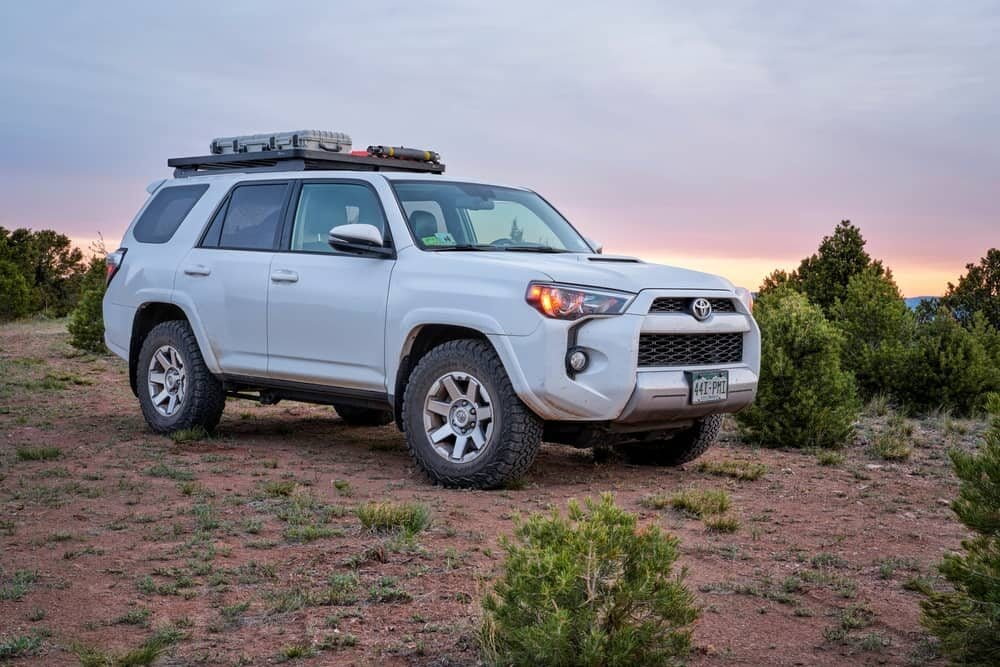What Years Did The Toyota 4Runner Have A V8?
If you’re looking for a Toyota 4Runner, you’ll find that there’s only one engine available, the 4.0L V6. With Dual VVT-i, this engine is trusty and delivers adequate performance.
But the Toyota 4Runner once had many engines to choose from, including a V8. Let’s find out what years did the 4Runner come with a V8, why it doesn’t anymore, and all the other necessary specs.

While you are researching 4Runners, be sure to bookmark the Toyota 4Runner category page and save these popular articles for future reading: What Are The Best and Worst Years for The Toyota 4Runner?, Pros & Cons Of Buying A 4Runner From A Dealer vs. A Private Party, and Jeep Wrangler vs Toyota 4Runner Comparison: Which Off-Road SUV is Right for You?
What Years Did The Toyota 4Runner Have A V8?
The Toyota 4Runner came with a V8 in the fourth generation, which went from 2003 to 2009. The 2003 and 2004 models came with the 2UZ-FE V8, which put out 235 hp and 320 lb-ft of torque. From 2005 on, VVT-i technology increased the output to 260 hp and 330 lb-ft.
The 4Runner used Toyota’s very popular 2UZ-FE. It had a cast-iron block, which increased the engine’s durability. It provided all its torque at lower revs, which made it ideal for SUVs and pickups. The 4Runner shared this engine with other Toyotas and Lexus vehicles such as the Tundra, Tacoma, and Sequoia.
While the powerplant was reliable, it did have some issues that were particular to its construction. These included manifold leaks and engine ticking.
Eventually, the engine proved to have high fuel consumption. As Toyota was improving other powerplants, it removed the V8 from the 4Runner. The replacement was the upgraded 4.0L V6.
The idea of a V8 4Runner is enticing. But this particular powerplant wasn’t the most efficient. In fact, performance figures with the latest V6 are very similar. Let’s learn more about the 2003-2009 Toyota 4Runner, the only one with a V8.
V8 4Runner Years Explained
The Fourth-Generation Toyota 4Runner
The fourth-generation 4Runner entered the market in 2002 with the 2003 model year. It was a mid-size, semi-luxury SUV aimed at people who wanted to mix both comfort and off-roading abilities in a single package. Known as the N210, it came with many upgrades from the previous generation.
The first of which was the inclusion of the 4.7L V8 under the hood. In the first two debut years of production in the United States, the V8 4Runner put out a respectable 235 hp with 320 lb-ft of torque. Toyota improved on its fuel injection technology and started it on all its vehicles. So, in 2005, they upgraded the engine with the new VVT-i system.
This improvement increased the horsepower to 260 and the torque to 330 lb-ft. But fuel performance took a big hit. On average, the V8 engine had an EPA estimated 15 mpg on the city and 19 mpg on the highway. This generation of 4Runner also came with the 4.0L V6 as an option, which produced 245 hp and 282 lb-ft of torque.
Though horsepower seemed similar, the V8 model outperformed its V6 counterpart in towing. V6 models towed a maximum of 5,000 pounds, while the RWD V8 version could tow up to 7,300 pounds. This difference was thanks to the more than 40 lb-ft increment on the 4.7L powerplant.
The 4Runner used a solid rear axle and double wishbone suspension in the front. This configuration made it ideal for off-roading and towing but, like most 4Runners, made its ride choppy at highway speeds. Cornering has never been the 4Runner’s strong point; this generation was no exception.
When the fifth-generation 4Runner entered the market, known as the N280, it came with two engine choices. And neither was a V8, meaning the fourth-generation model is the only generation of 4Runner with a V8. This move left many buyers disappointed, so let’s find out why Toyota made this move.
Why Did Toyota Stop Making A V8 4Runner?
There are several reasons why the Toyota 4Runner ceased to have a V8 engine. First of all, Toyota was aggressively promoting improved power plants. Now it’s commonplace, but the VVT-i system was brand new back then.
In the mid-2000s, manufacturers faced pressure to improve fuel efficiency in their engines. It wasn’t uncommon to see several models drop their larger engines from the lineup. Instead, they opted for smaller, more eco-friendly powerplants. Toyota was no exception.
They promised that the upgraded 4.0L V6 would be more powerful and more efficient. But the 4.7L V8 also had quality issues. Though usually recognized as a very reliable engine, the 2UZ-FE V8 sometimes had a cracked exhaust manifold.
As fuel emissions standards increased, Toyota had to find a way to decrease emissions on its V8 engines during cold starts. Also, Toyota added a second converter to the original catalytic converter into the exhaust manifold.
Converters need warming up before they can be fully efficient. So, Toyota thinned out the steel surrounded the catalytic converters. After many heating and cooling cycles, the thinner metal would crack. This problem leads to hampered performance and, worse, failed catalytic converters.
Though the problem wasn’t frequent, maintenance was vital in keeping the V8 in top conditions. But the 4.7L engine is picky. For example, the engine required that the timing chain be replaced every six years of average use, less if you’re a mile-eater. Each replacement costs $500 to $1200 per change, which can pile up in the long run.
Unfortunately, this wasn’t the only issue. The 2003-2005 versions came with rust issues. Though this wasn’t related to the engine, it generated a bad reputation for the early fourth-gen models.
Interestingly, the fourth and fifth-generation V6 4Runners are known for extreme reliability. They’re not perfect. Some have transmission issues and other common mechanical issues. But they can drive for hundreds of thousands of miles.
What Engines Replaced The V8 On The Toyota 4Runner?
The fifth-generation Toyota 4Runner had improved suspension, interior, styling, and transmission. Plus, it came with two engines. The most popular powerplant was the 4.0L V6 1GR-FE.
Tried and true, this engine was already on several Toyota vehicles. But, the 4Runner came with an improved injection system, thanks to VVT-i technology. Toyota promised that the V6 would perform just as well as the V8, and it did. To a degree.
The power was a respectable 274 hp, but the torque was 278 lb-ft, lower than that of the previous V8. This translated to a lower towing capacity, 2,000 pounds less, to be exact. And this was important to all those users looking to tow with their 4Runners. *Check out our article about towing with a 4Runner.
Fuel performance was like earlier engines, with 17 mpg in the city and 21 mpg on the highway.
But, there’s another relatively unknown engine. And, with due reason. During the first two years of production, the fifth-generation Toyota 4Runner came with a 2.7L I4 engine, which produced 157 hp. It was available only in 2WD models and was pulled out of the product line in 2010.
Since then, Toyota has stuck to a recipe that seems to work. The 4.0L V6 is responsive. It can carry the 4Runner through the most challenging terrains and has adequate power. But it’s a powerplant that has a decade of use. Yes, Toyota has improved the injection systems, but the 4Runner is beginning to show its age as competition improves.
So, if Toyota wants to stay competitive in the mid-size SUV market with one of the last true off-roaders, it must look to rejuvenate the 4Runner. And, with companies migrating to hybrids, it’s unlikely that we’ll see another Toyota 4Runner have a V8 ever again.
Closing Thoughts
This article wanted to answer what years did the Toyota 4Runner have a V8. Toyota produced the Toyota 4Runner with V8 engine options from 2003 to 2009, as part of the fourth generation. The fifth generation saw Toyota stop this option.
The Toyota 4Runner came with a 4.7L V8 that produced a respectable 235 hp and 320 lb-ft of torque during the first two years. Thanks to VVT-i, from 2005 on, the engine put out 260 hp and 330 lb-ft of torque.
But the V8 made the 4Runner thirsty, and it was unable to reach 20 mpg on the highway. The engine is reliable and has a reputation for going for hundreds of thousands of miles. But some presented cracks in the exhaust manifold. Toyota installed a second catalytic converter in the engines to follow emission standards on cold starts.
Engineers had to thin out the metal surrounding the second converter. Due to the expansion and then shrinking of the metal, the manifolds would crack, and the converters showed failure.
Toyota was already working hard on improving the 4.0L V6, which would eventually make its way to the 4Runner and become the mainstay engine. So, this combination of factors led to pulling the V8 out of the 4Runner lineup.
While the current engine delivers good power and torque, it’s already showing its age. Plus, the 4Runner isn’t the best-handling SUV thanks to its body-on-frame construction. So, it’s beginning to feel outdated compared to other SUVs.
But one thing is clear. The Toyota 4Runner is a solid 4×4. It can go for hundreds of thousands of miles, and its 4.0L V6 is reliable. We may never see a V8 in a 4Runner again, but we’re sure to see 4Runners on the road or off it for many more years.
More 4Runner Resources
If you enjoyed reading about the Toyota 4Runner, you will surely appreciate my other related articles. These articles delve deeper into specific aspects of the 4Runner such as its off-road capabilities, interior design and technology features.
Additionally, I have compared the 4Runner to other popular SUVs in its class to help you make an informed decision about your next vehicle purchase. Give them a read; I am sure you will find them as interesting and informative as the first article.



